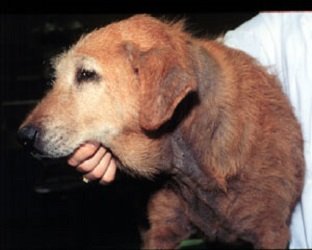When your dog is diabetic, he is more prone to other infections and diseases. Can diabetes in dogs cause skin problems? Yes! Give attention to even minor skin problems of your diabetic dog. A single cut can turn deadly if not treated on time. Diabetes makes the body sensitive.
When your diabetic dog’s condition is wearing off, bad skin is usually the first sign. In this article, we will discuss possible skin infections that occur commonly in diabetic dogs.

Dog diabetes skin problems
Mostly skin infection is the first symptom of underlying bad health conditions. Skin conditions in diabetes are alarming. Although they may not be an immediate emergency, you need to give special attention to their treatment. If you notice any slight change in color, luster, or texture of the skin, contact your vet.
A diabetic dog can get several skin conditions. Some of them are
Fungal infections
Grooming is vital for diabetic dogs. They can develop skin and nail infections. Mostly fungal infections develop in a moist area of skin. So if your dog is not having enough grooming sessions, he can develop a fungal infection in damp areas of the body like the lower belly, corner of the mouth, or under joints.
Also, dogs who have double coat fur are more prone to such infections if the undercoat is damp for longer periods. This is why it is important to dry your diabetic dog completely after swimming sessions.
A fungal infection will cause
- Redness
- Blisters
- Scales
- Itching
- Rashes
Bacterial infections
Bacterial infections are of a different kind. It can be a simple infection around the nail or a complex infection in deep skin layers. If you notice redness in any area of your dog skin along with swelling, it is mostly a sign of bacterial infection.
Bacterial infections cause
- Redness
- Swelling and
- In some cases pus
With proper medication, bacterial skin infections can be treated without any risk. High glucose levels for elongated periods accelerate bacterial infections. So keep your dogs’ glucose levels in check. (Read glucose level 500).
Also if your dog has a skin condition that is not getting better, check your dog for diabetes. Most bacterial infections don’t heal faster when your dog is diabetic.
Itching and rashes
In diabetes, poor circulation of blood can cause itching and rashes in your dog’s skin. Mostly this happens in the lower areas of the body. If your dog is obese, the chances of itching and rashes increase. As the lower legs have to carry that extra body weight too, it results in poor circulation.
Acanthosis nigricans
This is a skin condition that mostly happens due to insulin resistance. This condition is also linked to disturbed hormones. Which is again linked to diabetes.
Acanthosis nigricans cause skin pigmentation in dogs. It includes both discoloration and dark-colored skin patches. Obese dogs are more prone to acanthosis nigricans. Although some breeds like dachshunds have this as a hereditary skin condition. Other dogs get this due to illnesses like diabetes.
The symptom your diabetic dog has acanthosis nigricans include
- Brown pigmentation near body folds
- Dark skin patches
- Foul odor in dark patches
- Greasy skin near patches
- Inflammation
- Itching
- Lace pattern of inflammation on the skin
Dermatopathy or sores
This is another commonly occurring skin issue in diabetic dogs. Collies, sheepdogs, water dogs, and Belgian Tervurens are more prone to dermatopathy. It is a skin disease that causes discolored patches.
The main reason for dermatopathy in diabetic dogs is due to changes in blood vessels. This condition can easily be misunderstood as a symptom of old age. Old dog skin problems resemble diabetic dog skin problems. Good thing is that this is not very harmful because the patches do not open up or itch.
Necrobiosis lipoidica diabeticorum
This is another skin rash condition caused by issues in blood vessels. This disease is associated with diabetes and is severe because the patches are greater in size and can open up.
The symptoms that your dog has Necrobiosis lipoidica diabeticorum includes
- Redness
- Slightly raised patches
- Patches on legs, arms, and face
Although this disease is not contagious in rare cases, it can transform into skin cancer too.
Skin Allergies
Skin allergies can occur as a side effect of medicines or insulin. Many times when you inject insulin at the same place on the skin, it can cause bumps. Read our article on dog injection sites to know where you should inject insulin.
Also while giving any other medicine, keep an eye on the dog if there is any reaction to medicine.
Blisters
Blisters can happen in dogs due to high glucose levels. (Also Read double dose of insulin dogs). These are usually painless and go away within weeks. It’s important to keep blood glucose levels under control to prevent blisters from happening on the skin. Blisters usually occur on the feet and legs of diabetic dogs.
Eruptive xanthomatosis
This is a skin condition in which yellow firm bumps appear on the skin. The skin around bumps can be red and itchy. This happens when blood cholesterol levels are elevated. To control this condition, diabetes must be managed properly. When everything is under control, usually this condition goes away.
Digital sclerosis
This is stiffness in body parts due to elevated glucose levels. Dogs can get digital sclerosis when glucose levels stay high for long period. Read our article diabetic dog restless at night to know more about what could happen if glucose levels stay high. Digital sclerosis can cause thick waxy skin.
Disseminated granuloma annulare
Granuloma annulare is a type of skin rash that appears in a ring-like shape. This usually happens due to thyroid or diabetes. Steroids are given to treat this condition.
How to prevent skin diseases in diabetic dogs?
Diabetes can make harmless conditions worse. So it’s important to handle situations wisely. To prevent skin diseases in diabetic dogs
- Manage your dog’s diabetes well. Especially pay attention to high glucose levels. High glucose levels can cause infections to spread to a wider area with severity. Also, the skin condition does not improve well if glucose levels are high.
- Don’t use chemical products on your diabetic dog’s skin. Avoid shampoos or lotions on cracked skin. They can speed up inflammation.
- Keep your dog clean. Bathe him often and brush him regularly with gentle hands.
- Dry your dog instantly after swimming sessions or having a tour in rain. (Read why does my dog stays out in rain).
- Keep the areas between toes, underbelly, and joints dry. Moist skin can trigger fungal infections.
- Don’t ignore even simple cuts and wounds. Use ointments and septic wipe to treat the area.
- Keep the skin moist. Hydration is the first step to keeping skin moist and hydrated. Dry skin easily gets sore.
- Don’t let your dog out in extreme weather conditions. Cold weather can cause dryness and chap on the skin and hot weather can cause sweat. (Also read can huskies sleep outside in cold weather and can labrador survive hot weather).
- Don’t use dog accessories like tight collars or jackets. (read is seresto collar making dog sick and what size collar for golden retriever puppy).
- Use home remedies to solve skin issues.
- Consult your vet if the condition is persistent and is not improving.
Read how to prevent diabetes in dogs altogether.
How to treat skin problems in dogs?
If your dog is having one of the above skin conditions.
- The first step is cleanliness. This is the only way that guarantees that dog skin treatments will work.
- Use ointments and medicines for blisters, infections, and allergies.
- In some cases, steroids are given to dogs to improve skin conditions.
- Instead of chemical shampoos use an oatmeal bath. It also removes dryness.
- Let your dog do physical activities. It improves circulation and reduces the risk of skin conditions caused by poor circulation of blood.
- Improve your dog’s diet. Avoid too sugary or fatty foods. (Read Is Freshpet food good for diabetic dogs)
- If necessary, use medicated shampoos only.
- Massage your dog with vitamin E oil.
- Keep fleas and ticks away from your dog.
- Use antibiotics or medications given by the vet.
Conclusion
Diabetes can trigger and elevate certain skin conditions. It also has an overall bad impact on health. Treat skin conditions as a priority and if the situation doesn’t seem under control take a vet appointment.


My 10 year old collie/beagle is a diabetic and is on 17 units of insulin twice a day,he also has thyroid disease and has lost all of his hair. Yesterday I noticed a spot on the top of his shoulder blade that is raised,red and feels hard. With all the trips to the vet and all the medication I have with him sometimes it’s not affordable to take him for the little things so I’d like to try a home remedy. Do you have any suggestion?